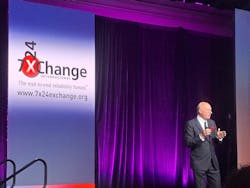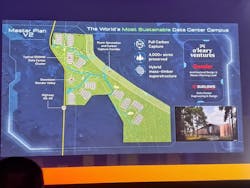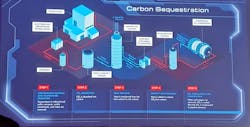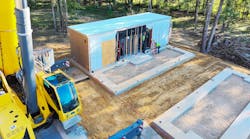Wonder Valley Revisited: Kevin O’Leary Expands on Power, Perception, and the Future of AI Infrastructure at 7x24 Exchange
Orlando, FL — When Kevin O’Leary first unveiled Wonder Valley to the industry at Data Center World in March, the reaction was electric. His keynote painted a bold picture: a 7,000-acre AI-first data center campus in Alberta, Canada, running off stranded natural gas and structured as a vertically integrated, off-grid energy platform. Now, just a few months later at the 7x24 Exchange Spring Conference 2025 in Orlando, O’Leary returned to the stage—sharpening his vision, expanding the project’s scope, and calling on developers to rethink what a data center can be.
This marked the second time in 2025 that Data Center Frontier has covered O’Leary in front of a packed industry audience. And while his message remained rooted in real estate, energy independence, and AI-fueled urgency, this latest speech reflected a notable evolution: more architectural specificity, stronger policy critique, and a renewed emphasis on aesthetics, community alignment, and public trust.
From Avatar to Alberta: Selling the AI Infrastructure Dream
O’Leary opened the latter portion of his 7x24 Exchange keynote with a striking AI demo: a side-by-side video of himself and a deepfake “AI Kevin,” asking the audience to guess which was which. It was hard to tell the difference.
“We shot it in two days for 70% less than we’d pay in LA,” he said. “And my wife couldn’t tell the difference for twenty seconds.”
While entertaining, the point was serious: AI agents, CRM automation, and content production are leaping forward, and every company—from watchmakers to physiotherapists—will soon need the compute capacity to build AI-native customer touchpoints. “Every single company I own is using these tools now,” he said.
This consumer-facing framing served as a segue into O’Leary’s central thesis: data centers are the real estate play of the decade, and the global economy can’t evolve without them.
“It’s Not About Data Centers. It’s About Power.”
O’Leary has become increasingly blunt in his framing of the power crisis.
In a moment that drew murmurs from the crowd, O’Leary offered a broader warning to developers still chasing capacity through traditional means. “If you go to any state and ask for a gigawatt off the grid—not a chance,” he said. “Not just because it doesn’t exist, but because ratepayers don’t want the lift on fees every power authority is going to hit them with.”
The solution, as Wonder Valley now makes plain, lies in unlocking underutilized resources. O'Leary reiterated what he told the crowd at Data Center World: stranded natural gas is the most viable near-term solution. But this time, he drilled down further.
“West Virginia, North Dakota, Oklahoma—they all have some. But Alberta? Alberta has six trillion cubic feet of stranded gas. That’s the granddaddy of them all.”
And so Alberta remains the spiritual and strategic heart of O’Leary’s data center bet.
Wonder Valley’s Second Reveal: AI-Rendered Architecture and Forest-First Design
At 7x24, O’Leary revealed new AI-generated visuals of Wonder Valley, now described as a 55-building, 35-million-square-foot campus with a 5.5GW IT load, expandable to 7.5GW using stranded gas turbines. The visuals weren’t just technical—they were narrative.
“This is a valley where technology and nature will come together in perfect harmony,” he said over a cinematic walkthrough. “A place where electrons, machines and data dance in algorithmic sync. Wonder is not just a name—it’s a mission.”
The campus layout intentionally preserves forest cover, integrates walking trails, and coexists with wildlife—designed in collaboration with Gensler, ZCorp, and Sudlows Engineering.
“We asked, why do we have to clear-cut the whole place?” O’Leary explained. “Why can’t we build these within the forest?”
More than just placemaking, the design is part of a broader strategy to counteract public resistance to data centers—a backlash that, O’Leary argued, started with square-block designs that clashed with nearby communities in Virginia.
“We have to change that perception,” he said. “These don’t have to be ugly. And that perception shift—that’s now part of our job.”
Community Buy-In, Carbon Sequestration, and the Permitting Playbook
As in his earlier keynote, O’Leary emphasized that Wonder Valley isn’t just a data center—it’s a regional development ecosystem.
The site features rail access, an onsite river, and is adjacent to an existing tech training center. His team is also provisioning land for carbon sequestration, and pitching the project to both hyperscalers and governments as a model of sustainable, scalable buildout.
“We’ve already taken First Nations leaders, Canadian ministers, and U.S. governors out there in helicopters,” he said. “When my partner Carl Agran landed in Alberta, blades still spinning, he told me: ‘Buy it all. This is a unicorn.’”
O’Leary credited Gensler for driving the “gorgeous” design ethos and emphasized that the variable CapEx of doing something beautiful “is practically nothing compared to the total cost of the project.”
But perhaps the most important new element he introduced was the data transparency strategy: full digital rooms and 3D renderings not just for investors, but for community stakeholders.
“If you don’t provide digestible data to the local community,” he said, “you’re not going to get it done.”
Lessons from Niagara, Scale from Norway
O’Leary once again referenced his early misfire in New York—an upstate project behind-the-meter in Niagara Falls that collapsed under permitting challenges. That site, he said, has since been replaced by an expanded facility in Norway and a growing footprint in Finland.
Those early detours, O’Leary suggested, weren’t setbacks so much as formative scrapes—lessons in navigating the brutal logic of grid reality. “New York is not a stable place for permitting,” he said flatly. “We moved it to Norway where it exists now, doubling in size.” That pivot laid the groundwork for his firm’s expanded European presence, including a new build in Finland—each move reinforcing his core thesis that the future of AI infrastructure belongs to those who lead with energy access, not land speculation.
“We learned to de-risk through energy first, not real estate,” he emphasized—a theme that continues to define the Wonder Valley playbook.
From 'Mr. Wonderful' to Data Center Diplomat: “The Hottest Sector in the Economy Right Now”
O’Leary framed the data center boom as not just a real estate trend, but an epochal shift akin to the Internet revolution. He cited a global demand of 45GW for new capacity, with only 500 construction starts in the U.S.—and argued that the real opportunity is in packaging these projects to meet hyperscaler demand with speed, sustainability, and optionality.
“There are only 18 groups globally who know how to do this,” he said. “You’ve got to aggregate land, power, fiber, permitting, and show it all in a data room. Then be ready to flip.”
Wonder Valley, he suggested, is not just a campus—it’s a replicable model.
And while CapEx remains a challenge due to global supply chain constraints, he pointed to infrastructure partners in the UAE and sovereign capital connections as key accelerants. “You’ll be on a plane to Dubai more than once,” he said with a grin.
O’Leary’s tone at 7x24 was more grounded and engaged than his earlier high-flown Data Center World debut. The big ideas were still there—but now accompanied by renderings, real policy critique, and an open mic session with developers.
“I’ve become an ambassador for data centers,” he said, “trying to explain this on TV and beyond.”
And the message, in short: if you want to build AI infrastructure, you’ll need more than steel and silicon. You’ll need story, land, policy, power—and above all, speed.
Final Word: Jobs, Justice, and a New Story for Data Centers
In closing, O’Leary returned to what he called one of the industry’s most overlooked imperatives: community engagement and reputational repair.
“Data centers have a bad rap,” he admitted. “There’s a picture floating around from Loudoun County—big concrete cube, smack behind someone’s house. It makes people crazy. And it’s a terrible image for all of us.”
At Wonder Valley, that public-facing narrative is being reengineered alongside the hardware. O’Leary emphasized the importance of architectural beauty, nature-forward design, and job creation as core elements of a new value proposition — particularly in Alberta, where the campus is being planned in close coordination with seven Indigenous communities.
“These centers create tens of thousands of construction jobs,” he said, “and then high-paying research and engineering jobs around them. But we have to show that. Every day. That’s part of my job now.”
When asked whether nuclear power might play a role in Wonder Valley’s future, O’Leary was pragmatic. “If it’s economically viable, I’m open to anything,” he said. “But if you can’t get below six cents per kilowatt-hour without subsidy, it doesn’t work. These models have to stand on their own.”
He cited gas pipeline giant Mackie McCrea as a power partner who understands this calculus. “I told him, point me toward a site where you can deliver me 6-cent gas, and I’ll build you a bigger seat,” he said. “It’s that simple.”
O’Leary also touched on leadership principles—citing internal portfolio data from O’Leary Ventures on why women-led startups consistently outperform. Companies led by women grew more modestly but hit their growth targets 95% of the time, retained key personnel longer, and returned capital faster.
“They kept the family together,” he said. “And when you’re only doing $10 million in revenue, losing your head of sales or compliance is brutal. The women founders mitigated risk and delivered higher IRRs.”
He concluded by connecting that same ethos to large-scale infrastructure.
“When you hit your targets quarter after quarter, people stick around. They want to win,” he said. “That’s how you build companies. That’s how you build data centers. And that’s how we’re building Wonder Valley.”
At Data Center Frontier, we talk the industry talk and walk the industry walk. In that spirit, DCF Staff members may occasionally use AI tools to assist with content. Elements of this article were created with help from OpenAI's GPT4.
Keep pace with the fast-moving world of data centers and cloud computing by connecting with Data Center Frontier on LinkedIn, following us on X/Twitter and Facebook, as well as on BlueSky, and signing up for our weekly newsletters using the form below.
About the Author
Matt Vincent
A B2B technology journalist and editor with more than two decades of experience, Matt Vincent is Editor in Chief of Data Center Frontier.





